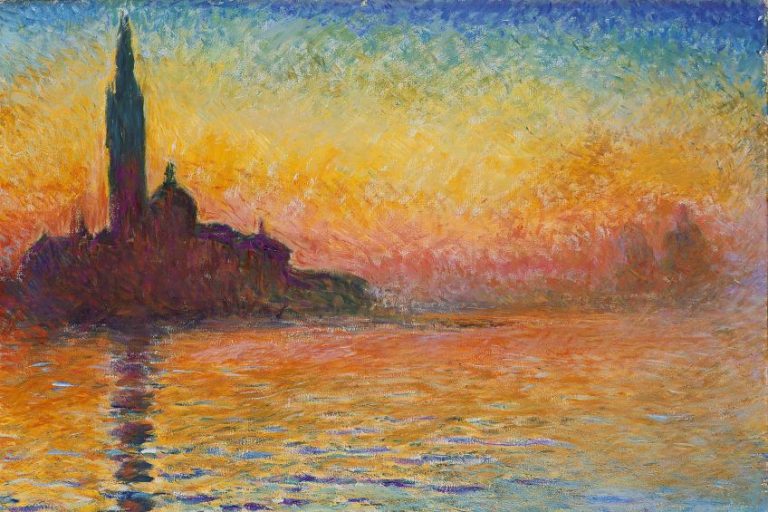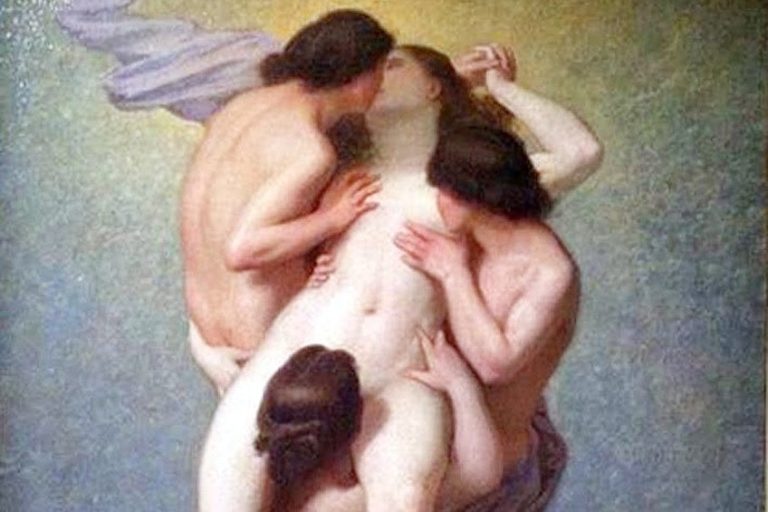Famous Medusa Paintings – Presenting Influential Medusa Art
Human history is full of mythological tales featuring monstrous beings such as Medusa, and many Medusa artworks have been created through the ages to memorialize this ancient tale. However, no two of Medusa’s head paintings look the same, and each artist has produced their personal interpretation of this feared entity. Many Medusa drawings are based on ancient Greek descriptions, yet each rendering of her visage differs due to artistic and cultural variations of the artists, and the time in which they were created. Here are some of the most famous Medusa paintings.
Our List of the Most Famous Medusa Paintings
Medusa was considered one of the most terrifying creatures in Greek mythology. She was a Gorgon, a creature portrayed as a human female with wings and live poisonous snakes for hair. Her superpower was straightforward: everyone who looked at her face would be turned to stone. According to a later version of the Medusa myth, as told by Ovid, the Roman poet, Medusa was initially a captivatingly beautiful maiden, desired by many, but after Poseidon sexually assaulted her in Athena’s temple, the incensed Athena changed Medusa’s beautiful hair into snakes and changed her face into something so terrifying that just the sight of it would turn observers to stone. Perseus considers Medusa’s chastisement by Athena as righteous and well-deserved in Ovid’s account.
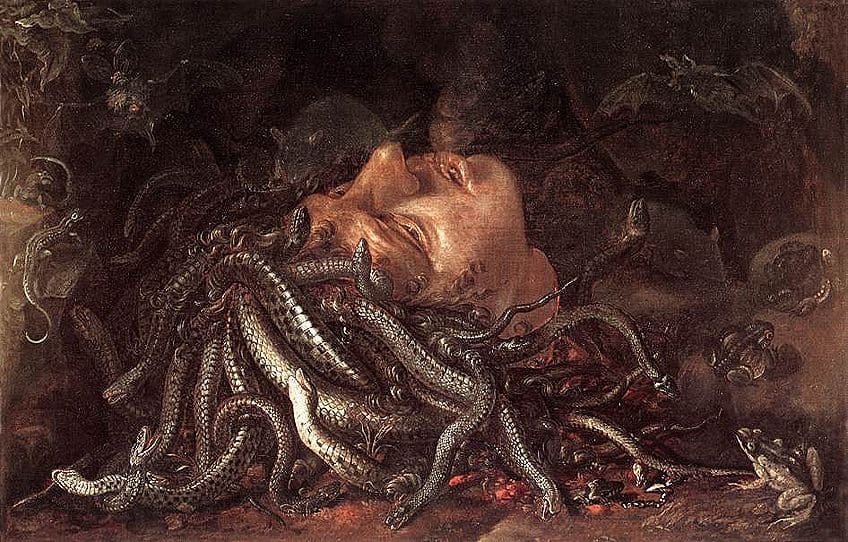
In most renditions of the narrative, she was decapitated by the warrior Perseus, who was ordered by King Polydectes of Seriphus to retrieve her head. The deities were well aware of this, and Perseus received assistance from them. Athena bestowed him with gold, winged sandals, a mirrored shield, Hephaestus’ sword, and Hades’ helm of invisibility. Perseus managed to kill Medusa while glancing at the reflection from the reflective shield he acquired from Athena, as she was the only one of the Gorgons who was mortal, and could be killed in this manner. Medusa was expecting Poseidon’s child at the time. A giant carrying a golden sword named Chrysaor, and a winged horse named Pegasus, burst from her body when Perseus decapitated her.
Medusa Mosaic (c. 1st Century CE) by Unknown
| Artist Full Name | Unknown |
| Date Completed | c. 1st century CE |
| Medium | Mosaic |
| Dimensions (cm) | Unspecified |
| Current Location | Kibrya, Turkey |
This Medusa artwork was recently discovered in an old Odeon in Kibrya, Turkey, and it is thought to date from the 1st century CE. According to what the restoration has revealed, this beautifully produced Medusa artwork concentrates on her eyes and expression. Medusa’s hair and the outline of her face are a blur, blending into the bright background. The pattern, paired with the brilliant color, increases the dynamic transition from the face to its surroundings in this Medusa mosaic.
Tragic and comedic themes dominated Greek theater and Medusa was an ideal topic for theatrical decorating since her myth was so dramatic.
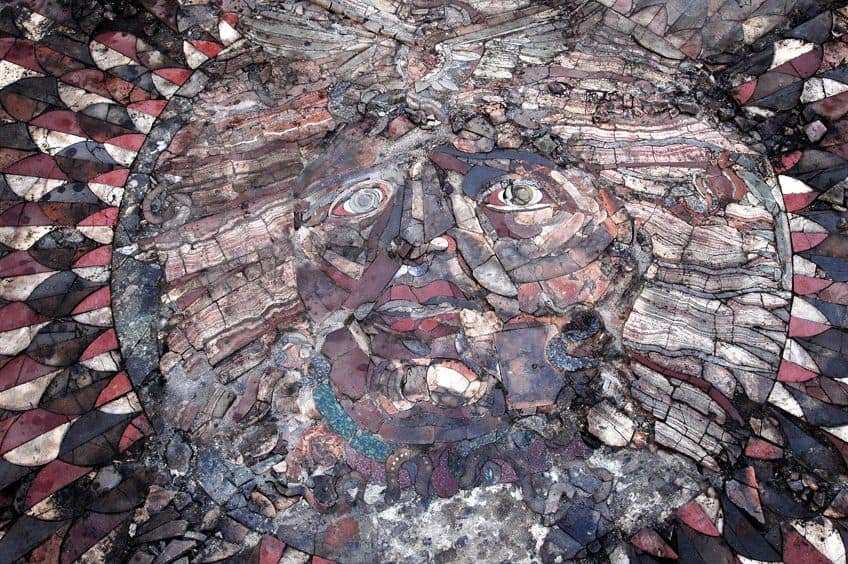
Poseidon, the god of the sea, raped Medusa in Athena’s temple, violating the sanctuary’s holiness. Athena was outraged with Poseidon but couldn’t exact revenge on him since he was a deity, so her anger fell on an unworthy victim: Medusa. The design of the mosaic emphasizes the depiction of Medusa’s curse. She is depicted overcome with disbelief and anguish. Gazing into Medusa’s eyes produces an illusionist effect, as the surrounding mosaic appears to vibrate slightly. Her sorrowful expression is designed to make the observer empathize with her curse.
Medusa-Murtola (1596) by Caravaggio
| Artist Full Name | Michelangelo Merisi or Amerighi da “Caravaggio” (1571 – 1610) |
| Date Completed | 1596 |
| Medium | Oil on canvas |
| Dimensions (cm) | 60 x 55 |
| Current Location | Uffizi Gallery, Florence, Italy |
In the 1590s, Caravaggio was only beginning to position himself as a renowned and successful painter in Rome. Yet, the period in which he painted the two Medusas was marred by frequent run-ins with the police. Caravaggio and his collaborator Prospero Orsi were bystanders in a crime that happened near San Luigi de’ Francesi in July 1597. Caravaggio’s works were never in sync with the idealized notions that were popular at the time. Rather, he grew more interested in the concept of realism and began to integrate it into his artworks. Caravaggio reached a watershed moment in his career when he painted Medusa: he was granted the opportunity to adorn the Contarelli Chapel, in which he produced realistic scenes based on the life of St. Matthew himself.
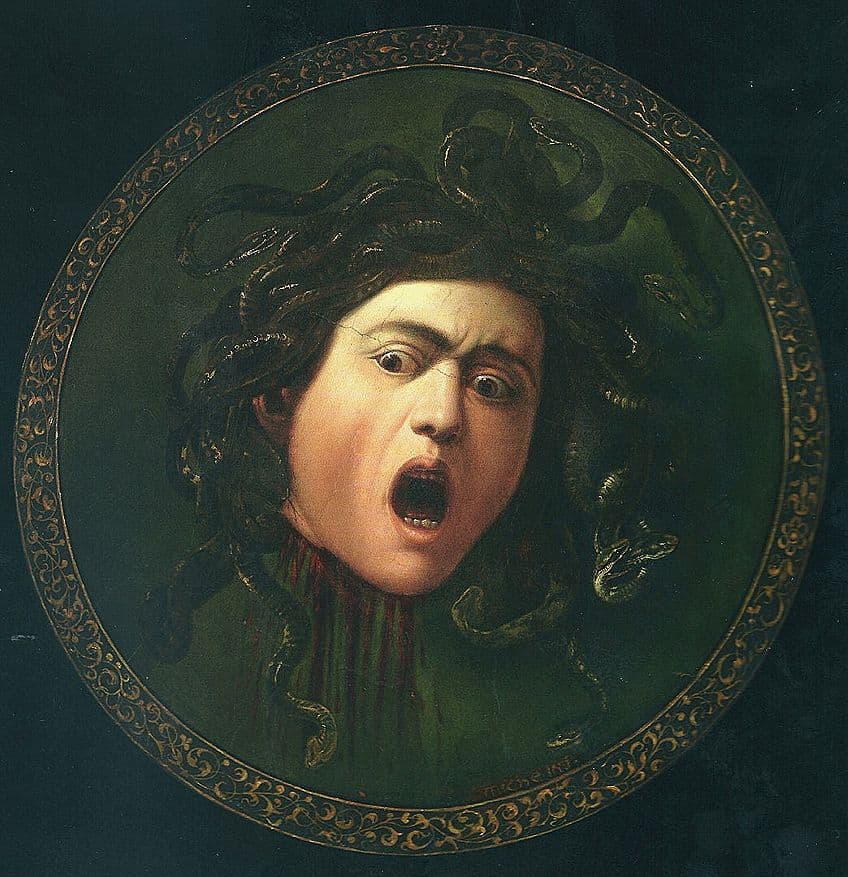
This opportunity to adorn the church provided him with a significant advantage and desire to infuse more realism into his paintings. Caravaggio portrays a self-portrait of his own features in place of Medusa’s as a manner of expressing his resistance to her horrible gaze in his Medusa artwork. Though the head has been severed, it seems to be cognizant as the artwork portrays its last breath after being horribly slain. Blood rushes down in several streaks, and the jaw hangs open, exposing her teeth. Medusa’s face is contorted in a horrifying expression, with brows wrinkled and eyes exaggerated.
Head of Medusa (1618) by Peter Paul Rubens
| Artist Full Name | Peter Paul Rubens (1577 – 1640) |
| Date Completed | 1618 |
| Medium | Oil on canvas |
| Dimensions (cm) | 69 x 118 |
| Current Location | Kunsthistorisches Museum, Vienna, Austria |
Rubens was a well-known and prolific Flemish artist throughout the first part of the 17th century. Regarded as one of the most prominent artists of his day, Peter Paul Rubens has produced a terrifying yet beautiful depiction of the decapitated Medusa. The serpents are maybe even more noteworthy than the decapitated head. Rubens did not illustrate these snakes personally but instead enlisted the assistance of Frans Snyders, an animal painter. Snyders depicted several snakes with various skins, forms, and folds.
Rubens had regularly collaborated with well-known artists such as Snyders in the past.

Two snakes are attacking each other in the upper right corner, which might be part of their mating behavior. Several snakes are grappling each other on the left. Little snakes are created from the blood that streams from Medusa’s neck, and a small two-headed snake can be seen in the center foreground. Rubens’ rendition of Medusa is horrific, from her glazed horror-filled eyes to her writhing serpent hair. Medusa’s face is pallid, her lips are black, and her pupils are gazing downward. A large amount of blood drains from her neck.
Head of Medusa (1680) by Godfried Maes
| Artist Full Name | Godfried Maes (1649 – 1700) |
| Date Completed | 1680 |
| Medium | Pen and ink |
| Dimensions (cm) | 24 x 18 |
| Current Location | The Art Institute of Chicago, Illinois, United States |
Maes’ artwork is one of the most well-known Medusa drawings and was rendered in pen and ink. Her face is scrunched up and seems to be screaming in pain and anger. The snakes twist and contort, with faces that appear almost rat-like. This exceptional piece, a tour de force of powerful penwork, may be ranked among Godfried Maes’s greatest-known drawings.

It was created by the artist as a stand-alone original work of art, well produced and meticulously dated and signed with drawn framing lines, presumably to be presented to a collector. Furthermore, the piece was a contemporaneous version of a kind of complex drawing style known as a federkunststuck – an ornate ink and pen drawing produced as a virtuoso replica of an engraving – created by artists of the preceding generation such as Jacob Matham and Hendrick Goltzius. Maes dealt with the concept of the Gorgon in at least two more Medusa drawings, both from the group of full composition drawings based on scenarios from Ovid’s Metamorphoses.
Medusa (1901) by Arnold Böcklin
| Artist Full Name | Arnold Böcklin (1827 – 1901) |
| Date Completed | 1901 |
| Medium | Painted paper mâché |
| Dimensions (cm) | 60 diameter |
| Current Location | Private collection |
Böcklin’s magnificent Medusa’s head painting exhibits the artist’s fascination with ancient and polychromed sculptures while rendering the myth in a strongly symbolist fashion. Böcklin had addressed the concept of Medusa in a number of artworks, one of which (about 1878) was formerly housed in the Germanisches Nationalmuseum in Nuremberg. This apotropaic picture of a live, severed head encircled by serpents was ideal for a symbolist interpretation since it plays on both terror and fascination, the real and the unreal. Böcklin produced a visual illusion by using the form of an actual shield and the two-and three-dimensionality of sculpture and painting.
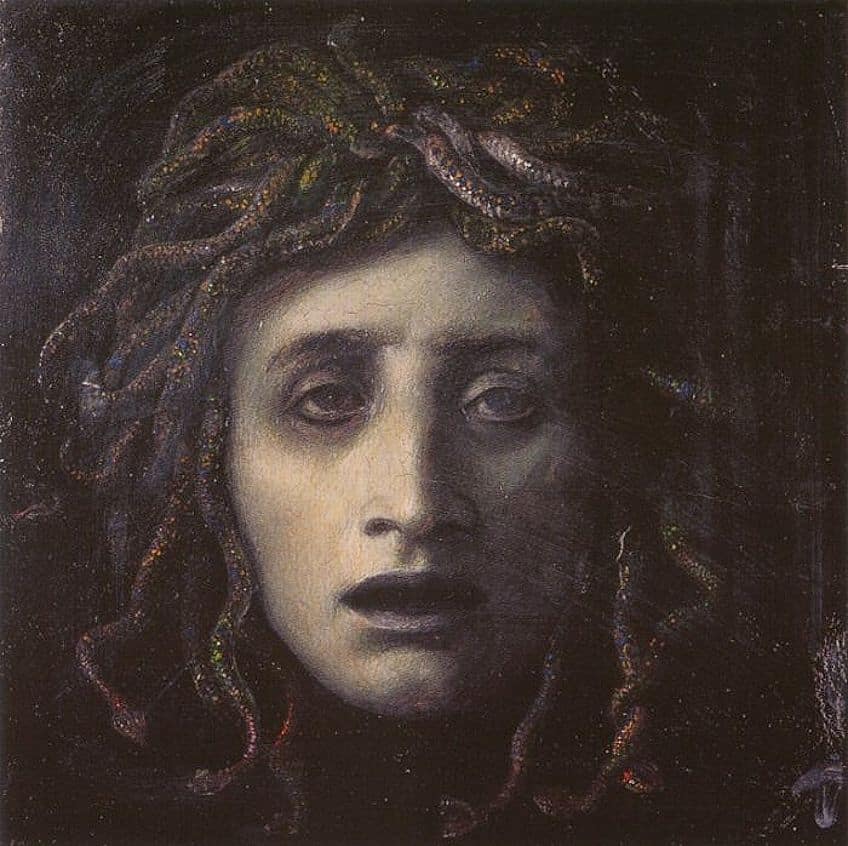
The initial version of this Medusa artwork, created in 1885, was damaged upon its return from the polychrome art show at the Nationalgalerie in Berlin later that year. In 1887, a second version was produced, which is presently housed in the Kunstmuseum Basel, and several casts were made. The current, rediscovered sculpture is the first Medusa relief to have surfaced at auction since 2007, having previously been in private ownership. Its initial owner was a member of a Munich drinking club that included Bruckmann and Böcklin, as well as other notable painters. Böcklin is claimed to have offered a Medusa rendition to each of his drinking companions in this convivial atmosphere, while probably drunk.
With that, we wrap up this list of famous Medusa paintings. Medusa’s head paintings reveal how prevalent this myth was throughout the ages. Medusa drawings and paintings have helped keep the myth in the public consciousness, forever reminding us of the sorrowful fate that befell the wretched Gorgon.
Take a look at our Medusa paintings webstory here!
Frequently Asked Questions
Who Was Medusa?
Medusa is a Greek mythological creature noted for her power to turn humans into stone with just one look. She was once a gorgeous woman, but Athena punished her by turning her into a beast with serpents for hair. Based on one version of the tale, Medusa was previously a priestess at Athena’s temple, before being violated by the sea deity Poseidon. As a consequence, she was chastised by Athena who turned her into a monstrous creature. Medusa was finally defeated by the warrior Perseus, who used a mirrored shield to avoid gazing directly at her cursed face. If one thinks about it, it is actually a rather sad tale, seeing that she was the victim of rape but was still further punished.
Why Was Medusa Depicted So Much in Art?
Because Medusa is a well-known character from Greek mythology, her tale has prompted the creation of a great number of artistic renditions through the ages. Over the centuries, the tale of Medusa has been interpreted and reinvented in a number of ways, and artists have found several ways to portray her in their works. The Medusa drawings by Maes, as well as the iconic Medusa paintings by Caravaggio, Rubens, and others, are among the most recognized portrayals of Medusa in art. Medusa’s narrative has been utilized as a metaphor for a variety of ideas and themes, notably change and power, in addition to being an intriguing and complex figure in her own right. In more recent years, the story has been reanalyzed and depicted from the victim’s point of view. It is now seen as a symbol of feminism.
Isabella studied at the University of Cape Town in South Africa and graduated with a Bachelor of Arts majoring in English Literature & Language and Psychology. Throughout her undergraduate years, she took Art History as an additional subject and absolutely loved it. Building on from her art history knowledge that began in high school, art has always been a particular area of fascination for her. From learning about artworks previously unknown to her, or sharpening her existing understanding of specific works, the ability to continue learning within this interesting sphere excites her greatly.
Her focal points of interest in art history encompass profiling specific artists and art movements, as it is these areas where she is able to really dig deep into the rich narrative of the art world. Additionally, she particularly enjoys exploring the different artistic styles of the 20th century, as well as the important impact that female artists have had on the development of art history.
Learn more about Isabella Meyer and the Art in Context Team.
Cite this Article
Isabella, Meyer, “Famous Medusa Paintings – Presenting Influential Medusa Art.” Art in Context. March 28, 2023. URL: https://artincontext.org/famous-medusa-paintings/
Meyer, I. (2023, 28 March). Famous Medusa Paintings – Presenting Influential Medusa Art. Art in Context. https://artincontext.org/famous-medusa-paintings/
Meyer, Isabella. “Famous Medusa Paintings – Presenting Influential Medusa Art.” Art in Context, March 28, 2023. https://artincontext.org/famous-medusa-paintings/.




